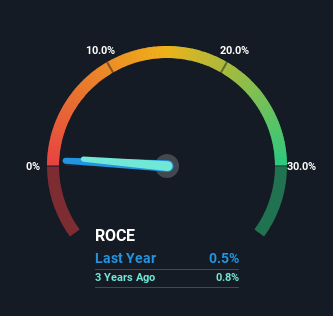Stock Analysis
- China
- /
- Healthtech
- /
- SZSE:000638
There's Been No Shortage Of Growth Recently For Vanfund Urban Investment and Development's (SZSE:000638) Returns On Capital

Did you know there are some financial metrics that can provide clues of a potential multi-bagger? Ideally, a business will show two trends; firstly a growing return on capital employed (ROCE) and secondly, an increasing amount of capital employed. Basically this means that a company has profitable initiatives that it can continue to reinvest in, which is a trait of a compounding machine. So on that note, Vanfund Urban Investment and Development (SZSE:000638) looks quite promising in regards to its trends of return on capital.
What Is Return On Capital Employed (ROCE)?
For those that aren't sure what ROCE is, it measures the amount of pre-tax profits a company can generate from the capital employed in its business. The formula for this calculation on Vanfund Urban Investment and Development is:
Return on Capital Employed = Earnings Before Interest and Tax (EBIT) ÷ (Total Assets - Current Liabilities)
0.005 = CN¥1.3m ÷ (CN¥860m - CN¥605m) (Based on the trailing twelve months to September 2023).
Thus, Vanfund Urban Investment and Development has an ROCE of 0.5%. In absolute terms, that's a low return and it also under-performs the Healthcare Services industry average of 13%.
View our latest analysis for Vanfund Urban Investment and Development

Historical performance is a great place to start when researching a stock so above you can see the gauge for Vanfund Urban Investment and Development's ROCE against it's prior returns. If you'd like to look at how Vanfund Urban Investment and Development has performed in the past in other metrics, you can view this free graph of Vanfund Urban Investment and Development's past earnings, revenue and cash flow.
How Are Returns Trending?
Like most people, we're pleased that Vanfund Urban Investment and Development is now generating some pretax earnings. While the business is profitable now, it used to be incurring losses on invested capital five years ago. In regards to capital employed, Vanfund Urban Investment and Development is using 38% less capital than it was five years ago, which on the surface, can indicate that the business has become more efficient at generating these returns. The reduction could indicate that the company is selling some assets, and considering returns are up, they appear to be selling the right ones.
On a side note, we noticed that the improvement in ROCE appears to be partly fueled by an increase in current liabilities. Effectively this means that suppliers or short-term creditors are now funding 70% of the business, which is more than it was five years ago. Given it's pretty high ratio, we'd remind investors that having current liabilities at those levels can bring about some risks in certain businesses.
The Key Takeaway
From what we've seen above, Vanfund Urban Investment and Development has managed to increase it's returns on capital all the while reducing it's capital base. And since the stock has fallen 25% over the last five years, there might be an opportunity here. That being the case, research into the company's current valuation metrics and future prospects seems fitting.
One more thing to note, we've identified 1 warning sign with Vanfund Urban Investment and Development and understanding it should be part of your investment process.
While Vanfund Urban Investment and Development isn't earning the highest return, check out this free list of companies that are earning high returns on equity with solid balance sheets.
Valuation is complex, but we're helping make it simple.
Find out whether Vanfund Urban Investment and Development is potentially over or undervalued by checking out our comprehensive analysis, which includes fair value estimates, risks and warnings, dividends, insider transactions and financial health.
View the Free AnalysisHave feedback on this article? Concerned about the content? Get in touch with us directly. Alternatively, email editorial-team (at) simplywallst.com.
This article by Simply Wall St is general in nature. We provide commentary based on historical data and analyst forecasts only using an unbiased methodology and our articles are not intended to be financial advice. It does not constitute a recommendation to buy or sell any stock, and does not take account of your objectives, or your financial situation. We aim to bring you long-term focused analysis driven by fundamental data. Note that our analysis may not factor in the latest price-sensitive company announcements or qualitative material. Simply Wall St has no position in any stocks mentioned.
About SZSE:000638
Vanfund Urban Investment and Development
Vanfund Urban Investment and Development Co., Ltd.
Mediocre balance sheet and overvalued.

